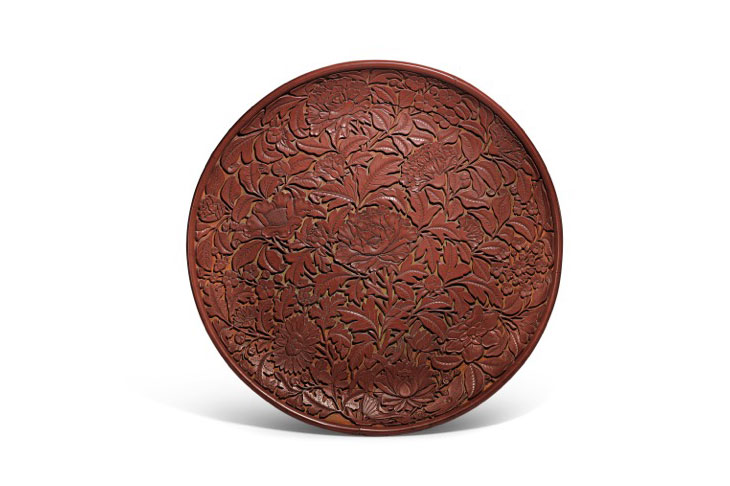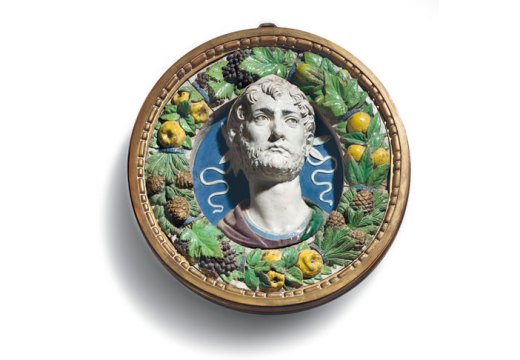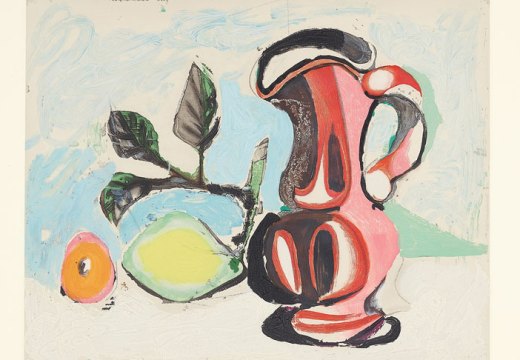Apollo’s regular insight into art market trends and highlights. Visit Apollo Collector Services for expert advice on navigating the art market.
So much modern and contemporary art is about process, with the methodology more important than the final product itself. It is a concept that would be incomprehensible to the maker of this exceptional and massive (45cm wide) cinnabar lacquer dish – a work of art manufactured using arguably the most laborious process of all.
Lacquer is a rather miraculous, unsung material. Made from the sap of a species of tree native to southern China but also cultivated in Japan and Korea, this resin hardens when exposed to oxygen and transforms into a natural plastic that is light, resistant to water and can withstand heat, and even certain acids. It can also be coloured by the addition of minerals, the most popular being a red form of mercury sulphide known evocatively as cinnabar. Little wonder that this material was favoured for domestic items throughout Asia.
No less importantly, lacquer also allows for the most precise and delicate of carving – although, for some reason, only the Chinese chose to do this. During the second half of the 14th century, this once humble artisanal craft was transformed by imperial patronage. For around 100 years, the imperial workshops produced lacquer wares of an unsurpassed scale and refinement, made for diplomatic exchange as well as court use. Unlike contemporaneous porcelain, however, this was not a process that allowed for large-scale series production.
First, a turned wood structure would be produced, and then the surface would be built up by at least 30 – and up to 200 – thin layers of lacquer, each one of which would have to dry before being polished and the next coat applied. Only then could the carving begin. The process could take years. In this example, carved in deep relief and set against a dull-gold ground, is a profusion of flowering plants: peony, chrysanthemum, two types of prunus and other blossoming fruits, pomegranate, lotus – the list goes on, as does the carving around the rim on the underside of the dish. Stems weave in and out of the branches, petals and leaves curl, and each detail is naturalistically rendered with botanical precision. Its underside also bears a needle-engraved signature with the name of Zhang Cheng, a famous Yuan dynasty lacquer carver documented in 1388.
Lacquers of this quality and scale are exceedingly rare – its closest counterpart is a dish in the Ashmolean Museum in Oxford. Such pieces could never have been produced in any quantity, and their fragile nature has ensured that even fewer survive. This dish appears to have no restorations or damage, and may well have spent much of its life in Japan where Chinese lacquers were revered and carefully boxed. It is first documented in the collection of the great British connoisseur and collector of Chinese ceramics Sir Percival David. When sold at Sotheby’s in 1962, this then little-understood tour-de-force fetched £650. It now returns to Sotheby’s for a fourth time (the last outing was in 1972 when it fetched £1,600). Offered on 10 May, the dish bears a notional estimate of £400,000–£600,000. It is up to the market to determine what it is worth today.
Visit Apollo Collector Services for the best information and advice about managing an art collection.
Unlimited access from just $16 every 3 months
Subscribe to get unlimited and exclusive access to the top art stories, interviews and exhibition reviews.














![Masterpiece [Re]discovery 2022. Photo: Ben Fisher Photography, courtesy of Masterpiece London](http://www.apollo-magazine.com/wp-content/uploads/2022/07/MPL2022_4263.jpg)
It’s time for the government of London to return to its rightful home